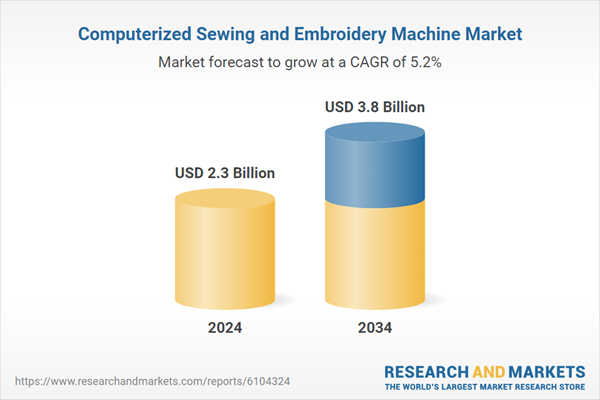The proliferation of online retail and changing consumer preferences have significantly influenced the demand for customized and fashionable clothing. With a growing appetite for fast fashion and unique designs, manufacturers are turning to automated solutions that can meet high productivity standards without compromising on precision. The development of organized retail networks, particularly in urban areas, has further encouraged the adoption of sewing and embroidery machines across different end-use settings.
Moreover, global market dynamics and constant policy shifts in the textile sector are amplifying competition, compelling manufacturers to innovate and upgrade their offerings. As a result, the integration of advanced features and smart technologies has become central to staying competitive, making computerized machines indispensable for both large-scale manufacturers and small production units aiming to stay ahead in a rapidly evolving industry.
In terms of type, the market is segmented into sewing machines, embroidery machines, and combination machines. Among these, sewing machines accounted for a significant portion, exceeding USD 1.6 billion in 2024, and are expected to grow at a CAGR of approximately 4.9% from 2025 to 2034. These machines enjoy widespread use across households and industries alike due to their adaptability, simplicity, and cost-efficiency.
Enhanced functionalities such as automatic thread cutting, pattern customization, and easy stitch selection are now standard in newer models, helping users produce high-quality garments with greater convenience. Policy support aimed at boosting local textile manufacturing has also contributed to the growth of this segment by making modern equipment more accessible.
When segmented by category, the market is classified into single-needle and multi-needle machines. The single-needle category held the largest share in 2024, capturing 60.8% of the total market, and is expected to reach USD 2.2 billion by 2034. Single-needle machines are favored for their speed, precision, and ease of use in standard garment production. They are increasingly being upgraded with digital controls that allow operators to adjust stitching patterns and monitor performance in real time. The demand for advanced single-needle machines is particularly strong in mature markets where quality standards are high and consumer expectations continue to evolve.
Based on application, the market is segmented into residential, commercial, and industrial categories. The industrial segment led the market in 2024 with a 46.3% share and is expected to maintain this position throughout the forecast period. Industrial-grade machines are essential for high-capacity operations where durability and speed are critical. These systems are engineered to handle extended usage without downtime, making them ideal for continuous production environments. Countries with a strong textile base and supportive government policies aimed at modernizing manufacturing infrastructure are contributing to the sustained growth of this segment.
The United States market surpassed USD 320 million in 2024 and is anticipated to grow at a CAGR of 5.2% through 2034. This growth is largely driven by a vibrant fashion ecosystem and a strong do-it-yourself culture, both of which are pushing the demand for sophisticated and user-friendly machines. The increasing adoption of automation and smart technologies in textile production is also fueling equipment upgrades. Import data reflects a consistent rise in the inflow of high-tech machinery designed for enhanced productivity and operational efficiency.
Manufacturers in the computerized sewing and embroidery machine market are leveraging multiple strategies to reinforce their market position. These include rolling out technologically advanced products, pursuing global expansion, establishing strategic alliances, and diversifying product portfolios to target various consumer segments. Companies are also responding to sustainability demands by exploring eco-friendly materials and energy-efficient technologies. Moreover, aligning with regional distributors and local retail partners has proven effective for market penetration, particularly in emerging economies.
Comprehensive Market Analysis and Forecast
- Industry trends, key growth drivers, challenges, future opportunities, and regulatory landscape
- Competitive landscape with Porter’s Five Forces and PESTEL analysis
- Market size, segmentation, and regional forecasts
- In-depth company profiles, business strategies, financial insights, and SWOT analysis
This product will be delivered within 2-4 business days.
Table of Contents
COMPANIES MENTIONED
The companies featured in this computerized sewing and embroidery machine market report include:- Baby Lock
- Bernina International AG
- Brother Industries Ltd.
- Durkopp Adler AG
- Elna International Corp. SA
- Husqvarna AB
- Janome Sewing Machine Co., Ltd.
- Juki Corporation
- Necchi Italia S.r.l.
- Pfaff Sewing Machines
- Ricoma International Corporation
- SunStar Precision Co., Ltd.
- Tajima Industries Ltd.
- The Singer Company Limited LLC
- ZSK Stickmaschinen GmbH
Table Information
| Report Attribute | Details |
|---|---|
| No. of Pages | 135 |
| Published | June 2025 |
| Forecast Period | 2024 - 2034 |
| Estimated Market Value ( USD | $ 2.3 Billion |
| Forecasted Market Value ( USD | $ 3.8 Billion |
| Compound Annual Growth Rate | 5.2% |
| Regions Covered | Global |
| No. of Companies Mentioned | 16 |









